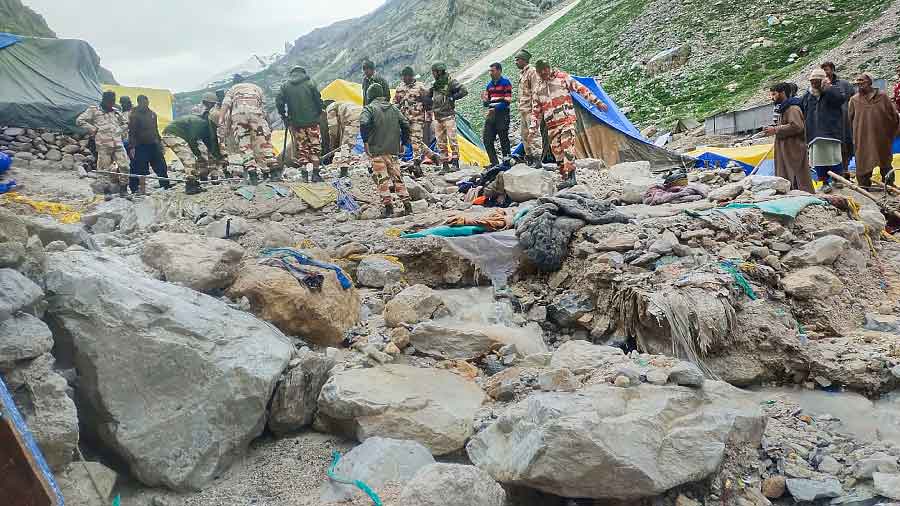
Early Surge and Weather Challenges
Over the first five days of this year’s Amarnath Yatra, more than 40,000 devotees have braved continuous heavy rainfall to reach the 3,888‑metre-high cave shrine dedicated to Lord Shiva in Jammu and Kashmir’s Himalayas. Despite monsoon-induced adversities across the trekking routes, the faith-driven pilgrimage has seen a spectacular surge of participants venturing via the Baltal and Pahalgam routes to experience the ice Shivlingam’s sanctity.
Pilgrim Toll and Health Hazards
The pilgrimage has also witnessed tragedy. Five pilgrims lost their lives, three to cardiac arrests, one from a fall, and another due to an undetermined health emergency along the route. These incidents underscore the daunting combination of high altitude, unpredictable weather, and the strenuous nature of the journey. Health officials emphasize that altitude sickness, hypothermia, and pre-existing conditions remain serious concerns for many yatris.
Robust Medical and Safety Infrastructure
Authorities have retooled medical and safety operations to adapt to this year’s challenges. Over 100 doctors have been deployed to perform compulsory health checks at entry points in Jammu. Along the trekking trail, advanced medical camps equipped to handle emergencies are stationed at strategic points. Dr Mushtaq Ahmad Rather, Director of Health Services in Kashmir, confirmed that “we’ve expanded our medical infrastructure along the Yatra route”, ensuring swift treatment and crisis management.
Resilient Security Measures
With two major routes, 14 km via Baltal and 48 km via Pahalgam, security has been reinforced to deter threats and maintain order. Nearly 40,000 personnel, including Jammu and Kashmir Police, paramilitary forces, Army units, National and State Disaster Response Forces, are active along the pilgrimage paths. Additional tools, such as RF vehicle tracking, drone monitoring, and motorcycle patrols equipped with cameras, bolster real-time surveillance and response.
Record-Breaking Momentum Despite Weather
The Yatra has smashed previous participation records. While earlier years recorded similar figures only by the tenth day, this year’s 40,233 pilgrims had already performed the darshan by the morning of the fifth day. By the eighth day, total attendance swelled to approximately 159,000, nearly doubling last year’s intake in just over a week. The impressive turnout signals a resilient devotion overshadowing the compelling risks posed by monsoon conditions.
Operational Pause and Strategic Restarts
Heavy rainfall briefly forced suspensions of the Yatra on both routes, marked as precautionary safety measures. During those intervals, coordination between security forces, IMD weather advisories, and medical teams facilitated responsive halts. When conditions improved, helicopters evacuated stranded groups, and pilgrim convoys resumed under stricter escorts.
Pilgrim Perspectives
Yatris report a deeply spiritual and triumphant experience. One pilgrim from Delhi shared, “It was a great journey. The weather was a little hot as there were no rains but only scorching sun.” Another remarked, “I am feeling good. I am very excited about this journey… I want to thank the government for all the facilities here.” Despite the rain delays, many describe the trek as a transformative experience, punctuated by communal resilience and devotion.
Infrastructure & Logistic Enhancements
To support the inflow and safety of pilgrims, command control centres have been set up with representatives from over 20 departments, including Police, CRPF, NDRF, PHE, telecom, and power distribution. Over 124 community kitchens (langars) and 7,000 volunteer sevadars ensure food and shelter availability along the trails. Medical camps are spaced roughly every two kilometres, with layered facilities from Pahalgam to Baltal.
Comparing Routes: Baltal vs. Pahalgam
The Baltal route, spanning 14 km, caters to those seeking speed, yet entails steep and narrow ascents that challenge older or unfit pilgrims. Meanwhile, the longer Pahalgam route (48 km over three days) offers a scenic yet physically demanding experience, winding through locations such as Pissu Top, Sheshnag, and Panchtarni.
Looking Ahead: A Long Yatra Journey
The pilgrimage commenced on June 29 and will continue for approximately 52 to 57 days, concluding in mid‑August around Shravan Purnima/Raksha Bandhan. Officials aim to maintain high service levels through this period, anticipating total attendance ranging between 350,000 to 500,000 pilgrims, mirroring or surpassing figures in recent years.
Balancing Faith and Caution
This year’s early surge highlights pilgrims’ unwavering devotion, undaunted by relentless rain, health threats, or logistical hurdles. However, the five fatalities record a sombre note, reminding authorities and participants alike that high altitude pilgrimage requires deep respect for health, environment, and preparedness.
In summary, the Amarnath Yatra’s early momentum, marked by over 40,000 pilgrims in just five days, medical fluency, and brisk security operations, demonstrates both escalating devotion and evolving readiness. As the yatra progresses, continued vigilance, timely weather interventions, and enhanced infrastructure will be vital to harmonize spiritual journeys with safety and environmental stewardship.




































Leave a Reply